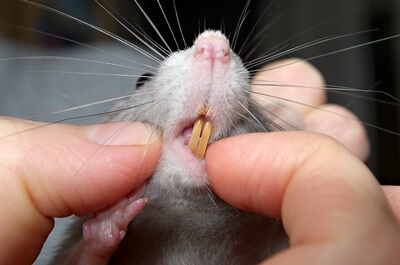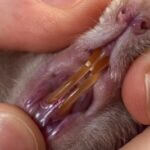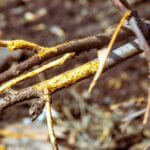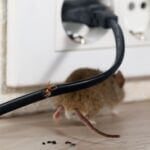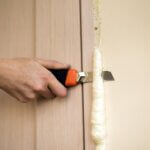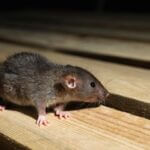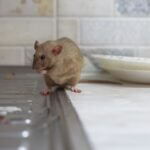Rats’ teeth are designed for gnawing. Rats gnaw relentlessly to keep their teeth filed and prevent them from growing out of proportion.
We must consider their dental anatomy to understand why rats’ teeth are so strong.
Rats have 16 teeth: 4 incisors for gnawing, 2 incisors on the upper jaw, and 2 molars on the bottom jaw. They also have 12 molars, which break down food into tiny chunks that are easy to swallow.
Rats don’t have premolars, as their jaws have a space known as a diastema.
Gnawing allows rats to keep their teeth sharp and gives incisors a curved appearance. Only the outer layer of a rat’s incisors is coated in a hard yellow enamel.
Therefore, when rats gnaw, the inside of their incisors wears away faster than the outside, giving them a curved appearance.
Do Rats Have Premolars?
As mentioned, rats have only 16 teeth comprising 4 incisors and 12 molars. The incisors are located at the front of the mouth, with 2 on each jaw. They’re primarily used for gnawing.
According to the Journal of the American Association of Laboratory Animal Science, rats’ incisors don’t have roots, so they never stop growing.
Rodents grind them on hard surfaces to keep these teeth from growing out of proportion.
The molars, which comprise three pairs on each jaw, are used to pulverize food to make swallowing easier.
Rats have a space (diastema) between the incisors and molars on each jaw. This space is filled with their cheeks, allowing inedible material to fall out of their mouths when chewing.
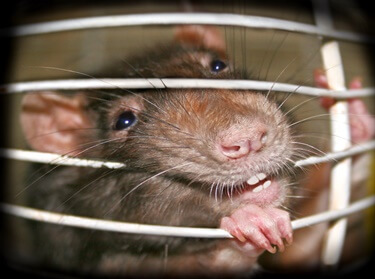
Do Rats Have Canine Teeth?
Rats don’t have canine teeth.
Rats have a space on each side of their mouths between their incisors and molars. This allows rats to suck in their cheeks when chewing to prevent non-edible material from entering their throats.
What Are Rat’s Teeth Made Of?
The outer parts of a rat’s teeth are enamel, while the inner section is soft dentine. The incisors on their top and bottom jaws grind against each other as the rat gnaws.
This causes the dentine to wear away faster than the enamel, giving rat incisors their characteristically curved appearance despite not being curved.
Why Are Rats’ Teeth So Strong?
While rat teeth are small in size, they’re tough. They can chew through some of the hardest materials, including wood, metals, and certain types of concrete.
The Mohs scale ranks rat teeth higher than human teeth in toughness.
While human teeth rank 5.0 on this scale, rat teeth are ranked at 5.5. This explains why rats can cause so much damage to property with their relentless gnawing once they get inside your home.
Rats can deliver strong bites while gnawing due to the musculature of their jaws. The attachment point of the muscles in their lower jaws moves forward toward the nose than in humans and other mammals.
Moreover, the muscles attached to the lower jaw are anchored in the eye sockets just behind the eyeballs, which is why a rat’s eyeballs vibrate in and out as it chews.
Do Rats’ Teeth Grow Back?
According to Exotic Animal Practice, rats have monophyodont teeth.
In other words, rats have only one set of teeth that continuously grow throughout their lives. So, rats’ teeth will grow back as long as they aren’t knocked out or broken in an accident.
If a rat loses teeth from its upper jaw, the teeth on its lower jaw will continue to grow even while the upper teeth are missing. This means the lower jaw must be trimmed until the new upper teeth grow.
After which, it can grind its teeth together to keep them in shape.
Why Do Rats Teeth Never Stop Growing?
As mentioned, rat teeth don’t have roots, so they continuously grow. This is useful in an evolutionary sense since it allows the rodents to gnaw and chew food for sustenance.
However, the lifelong growth of a rat’s teeth also presents problems.
Overgrown teeth can make it difficult for them to eat properly. Furthermore, if a tooth grows unchecked, it can tilt at an odd angle, piercing their mouths and causing injury and infection.
An overgrown tooth can cause death if it grows long enough to puncture the brain.
To prevent this, rats constantly grind their teeth to wear them down. This not only prevents overgrowth but also keeps the teeth sharp.
Rats wear down and renew their teeth every 40-50 days.
Rat Teeth Facts
Rats have a unique dental anatomy that sets them apart from other mammals.
Here are some interesting facts about rats’ teeth:
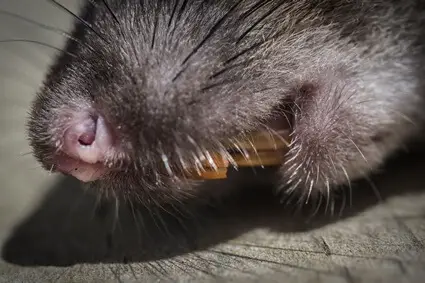
Rats’ Teeth Grow Throughout Their Lives
A rat’s front teeth are open-rooted, so they grow continuously throughout its life. Rats’ incisors are estimated to grow 4-5 inches each year.
However, rats won’t allow their teeth to grow out of control, making it difficult or impossible for them to eat and survive. Instead, they constantly gnaw and grind their teeth to wear them down.
It’s estimated that rats renew their front teeth every 40-50 days.
Rats’ Teeth Can Grow Back After Falling Off
Rats can regenerate their front teeth if they lose them in an accident. The remaining teeth will continue to grow even when the rest are missing.
Rats must grind their remaining teeth on hard surfaces to keep them trimmed as the new front teeth grow.
Rats’ Teeth are Harder Than Human Teeth
According to the Mohs scale, which ranks minerals in their order of toughness from least to most hard, rats’ teeth are significantly tougher than human teeth and even some types of metal.
This scale gives rats’ teeth a ranking of 5.5. By contrast, human teeth have a ranking of 5.0.
Considering this, it’s unsurprising that rats can gnaw through some of the toughest materials, including aluminum, iron, copper, cinder blocks, glass, and wood.

